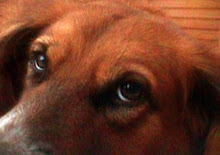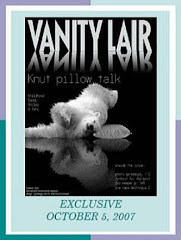 Wer sich fragt, was denn hier vor sich geht..., das ist Glacier, 14 Jahre alt, aus dem Point Defiance Zoo in Tacoma bei einer erneuten Wurzelkanalbehandlung. Erst letztes Jahr hatte er schon mal eine...Glacier stammt übrigens auch aus Churchill, im Alter von knapp einem Jahr kam er mit seinem Bruder Blizzard 1996 in den Point Defiance Zoo, nachdem sie verwaist aufgefunden wurden.
Wer sich fragt, was denn hier vor sich geht..., das ist Glacier, 14 Jahre alt, aus dem Point Defiance Zoo in Tacoma bei einer erneuten Wurzelkanalbehandlung. Erst letztes Jahr hatte er schon mal eine...Glacier stammt übrigens auch aus Churchill, im Alter von knapp einem Jahr kam er mit seinem Bruder Blizzard 1996 in den Point Defiance Zoo, nachdem sie verwaist aufgefunden wurden.
The patient needs a root canal.
He weighs 950 pounds, stands about 9 feet tall and is a top-of-the-food-chain predator.
So, what do you do?
Well, you dart him with a tranquilizer. Get about 10 strong backs to roll him onto a superstrong webbed net and lift him onto a pallet. Bring in a forklift, heft him into a truck and haul him off to the hospital. Forklift him out of the truck, get him onto a heavy duty gurney and call in a human endodontist who thinks it’s fun to look into a polar bear’s massive maw.
Other than that, the root canal performed at Point Defiance Zoo & Aquarium on Glacier the polar bear Saturday morning seemed remarkably similar to human dentistry.
There was a noisy, brrrrrrrrring drill. There were those very pointy, razor sharp files dentists use to clean out and enlarge the tooth cavity before they seal it off.
However, there was no expensive crown for Glacier. No nitrous oxide, or laughing gas.
For a root canal on a polar bear, conscious sedation won’t do at all. You need him fully knocked out, completely immobilized.
And he was a bit of a Grumpy Gus about it all to begin with.
“He was pretty angry with me this morning,” zoo veterinarian Dr. Karen Wolf said as he lay placidly on the gurney, his huge pink tongue lolling to one side while endodontist Dr. Edmund Kwan of Tukwila attended to Glacier’s fractured right maxillary canine.
Smart bear, Glacier. He knew what was coming when Wolf showed up with her dart gun.
Though she tries to do the deed quickly “to minimize stress on the animal” Glacier got enough of a look-see to jump up and down on his hind legs, pound his paws into the concrete, shake his head to and fro, saliva flying out of his mouth, and make a chuffing noise.
Once thoroughly sedated and secured in the surgery suite, he looked like a huge polar-style teddy bear – except for the IV line dripping saline and electrolytes into his massive right foreleg from a 3,000 milliliter bag; the endotracheal tube down his throat to help him breathe as anesthetic gas kept him asleep; the ventilator on standby in case it was needed; and the equipment monitoring oxygen saturation, carbon dioxide levels, heart rate and temperature.
At one point, Kwan, working with magnifying loupes over his eyeglasses, pulled a stringy piece of pulp about 3 inches long out of the tooth. He mopped up bleeding with gauze.
Veterinarians Wolf and Dr. Holly Reed, stethoscopes around their necks, kept their trained scientific eyes on their patient. Their tender hands periodically felt his heaving chest, and their expert ears listened to the beating of his great heart.
They were as caring as loving children caressing a beloved pet. But this is serious business. Polar bears are a vulnerable species. Zoos like Point Defiance care for and exhibit them as part of a Species Survival Program designed to preserve their kind and to educate the public about their challenges.
“Once you see a polar bear up close like this, you can’t get it out of your mind,” Wolf said.
The black pads of his feet felt a bit like rough microsuede. His matted fur was coarse on his body, but soft on his ears. His black nose twitched as Kwan worked on his tooth.
It wasn’t Glacier’s first root canal. Kwan, who volunteers his time, did one on the bear in 2008.
Zoo officials don’t know how he fractured his tooth; they recently discovered it during a routine check. Zookeepers use hand signals to get the bears to open their mouths for daily visual inspections, general curator Karen Goodrowe Beck said.
They began the week-and-a-half planning for the root canal shortly after keepers noticed the break, which could have come from anything from wrestling with another bear to chomping down on the beef femurs and knuckles he gets to eat along with a mixture of fish and dog chow, she said.
Getting to the broken tooth quickly can forestall a dangerous infection – and a massive, bear-sized, toothache, she added.
“Dental issues are a common procedure in polar bears, but it’s always a big deal when we immobilize an animal of this magnitude,” Wolf said.
The procedure began around 10 a.m. By 1 p.m., medicated and groggy but up and moving, Glacier was back home with his bear buddies.
And no doubt hoping for fish soup instead of beef bones for dinner.
About Glacier: Together with his brother Blizzard he was rescued as an orphan cub of about 11 months on Sept. 15, 1996, at Churchill, Manitoba, Canada and has lived at Point Defiance Zoo & Aquarium ever since.
Source & photo credits:
-The News Tribune Tacoma/20.12.09
-Point Defiance Zoo
Related posting:
Mit Pfeil und Bogen,wenn ein Eisbär eine Wurzelkanalbehandlung braucht, incl.Video














































Keine Kommentare:
Kommentar veröffentlichen